8 Tips for Keeping Your Houseplants Healthy in Winter
Reduce watering, stop fertilizing, move your indoor plants into the light and more
Lauren Dunec Hoang
January 8, 2018
Houzz Contributor. Landscape designer, a former garden editor for Sunset Magazine and in-house designer for Sunset's Editorial Test Garden. Her garden designs have been featured in the Sunset Western Garden Book of Landscaping, Sunset Western Garden Book of Easy-Care Plantings (cover), Inhabitat, and POPSUGAR.
Houzz Contributor. Landscape designer, a former garden editor for Sunset Magazine... More
Winter can be one of the easiest times to accidentally kill your houseplants. Lower light levels, dry air and temperature fluctuations with indoor heat can all create challenging growing conditions. Without switching up your care routine, your best intentions — such as keeping the soil moist — can cause houseplants to decline or give up altogether.
These eight tips can help you change up your care routine over winter and set up your houseplants to thrive until spring.
These eight tips can help you change up your care routine over winter and set up your houseplants to thrive until spring.
1. Dial back water. Most houseplants, with a few exceptions, go dormant in winter and need far less water than they do the rest of the year. How frequently you need to water depends on the plant type, temperature and dryness of your indoor environment and plant’s placement (mainly, how far it is from a radiator or other heating unit). Allowing the soil to dry out between waterings can help prevent root rot.
A good rule of thumb for dormant plants is to allow the top 2 inches of soil to dry out between waterings and wait until the pot, when lifted, feels relatively lightweight. (This means there’s no heavy, soggy soil at the bottom.) You may be able to wait from two weeks up to a month between waterings, depending on the temperature and humidity level of the room.
Indoor citrus plants and lucky bamboo are two common exceptions to the rule and require consistent moisture during winter. While citrus plants need less water than they do in summer, winter is the fruiting period. Be careful not to let the soil dry out completely, which can lead to fruit drop. Lucky bamboo needs to be kept moist year-round and can be cultivated in jars of water instead of moist soil.
2. Move plants to maximize light. With fewer daylight hours and less intensity of ultraviolet in winter, houseplants that were thriving in one spot may need to be moved closer to windows where they’ll receive more light. Wash windows inside and out to maximize how much light can reach indoor plants, and your room will feel brighter — something that’s always welcome in the darkest months of the year.
3. Give plants a rinse for dust. Broad-leafed house plants like ficus, some palms, bird of paradise tree (Strelitzia nicolai) and rubber plant (Ficus elastica) can quickly collect a lot of dust, cutting down on their ability to take in light. You can easily rinse off small potted plants by bringing them into the shower and spraying the leaves with cool water (and giving them their monthly or bi-monthly watering while you’re at it). For large potted plants, use a damp cloth to wipe down the leaves.
4. Move plants away from heaters. As we turn up the heat in winter, it can be easy to forget the effects increased temperature has on houseplants, particularly those in close proximity to heating units. To eliminate any risk of toasting leaves or roots, move all houseplants well away from radiators. If you keep your home on the warm side, check to make sure the soil in pots never gets bone-dry (the pot will be very lightweight when lifted).
5. Do a bug check. Regularly check houseplants for signs of pests, isolate infected plants and treat rapidly. Indoor plants are often more susceptible to pests and, once they get them, it’s harder for houseplants to shake them off in the absence of natural predators like insects or birds.
Spider mites are common on houseplants like fiddleleaf fig (Ficus lyrata) and show up as tiny, powdery white specks on leaves and in areas where leaf stems meet the trunk. Remove by squashing them between your fingers, then wipe leaves with a damp cloth or diluted horticultural oil.
Spider mites are common on houseplants like fiddleleaf fig (Ficus lyrata) and show up as tiny, powdery white specks on leaves and in areas where leaf stems meet the trunk. Remove by squashing them between your fingers, then wipe leaves with a damp cloth or diluted horticultural oil.
6. Hold the fertilizer until spring. Just as dormant plants don’t need much water, they also don’t need to be fertilized. At best, the fertilizer will just go to waste and be washed out of the pot. At worst, fertilizer applied in winter and not taken in by the plant can build up in the potted soil to levels that are unhealthy to the plant. Hold off until spring for any houseplants you feed regularly.
7. Repot, if needed. Two signs to look for if your plant needs repotting: yellowing leaves or the pot won’t hold much water — there’s barely space for soil due to pot-bound roots. Winter is a good time to upgrade plants to larger containers before they start their spring growth. Repot by gently tugging the plant out of the pot, loosening any root-bound roots and placing in a larger container with fresh potting soil.
8. Get a humidifier. If you live in an arid climate or keep the heat on in winter, a humidifier can make a big difference in keeping tropical houseplants healthy in dry indoor environments. In place of a humidifier, plan on frequently hand-misting plants like orchids, ferns and bromeliads that appreciate more humidity.
Browse humidifiers
Browse humidifiers
Your turn: Are houseplants cheering up your indoor environment this season? In the Comments, tell us how you keep them happy and healthy.
More
High-Impact Houseplants for First-Timers
How to Keep Your Holiday Plants Happy Now
More
High-Impact Houseplants for First-Timers
How to Keep Your Holiday Plants Happy Now
Related Stories
Apartment Life
How to Tell if Your Houseplant Needs Water
Keep your houseplants healthy by giving them the right amount of water
Full Story
Life
How to Simplify Your Life, All Year Long
Follow our 12-month plan to keep your to-do lists manageable and your home in good order
Full Story
SH Armchairs & Accent Chairs
This Season's Bestselling Accent Chairs and Tables
By Houzz
Update your room’s look with seats and surfaces that match your style
See Products
Your First House
10 Style-Boosting Design Ideas for Your Houseplant Collection
Nuts about houseplants? Check out these ways to make a bigger impact with your indoor potted displays
Full Story
Holidays
A Clean Home for the Holidays in 5 Days
Follow this guide to get your house clean before the festivities begin and your family and friends arrive
Full Story
Bathroom Design
A Bali-Inspired Bathroom Soothes With Spa-Like Luxury
Earthy elements and meticulous planning create a harmonious master bathroom
Full Story
My Houzz
My Houzz: A Limited Budget Makes Creativity Shine
Homemade pieces like a floor lamp made from an olive branch add a special touch to this labor of love in Italy
Full Story
Bathroom Makeovers
Before and After: 9 Small-Bathroom Makeovers That Wow
Ready to remodel? Get inspired by these bathroom projects that are less than 60 square feet
Full Story
Decorating 101
How to Nail Design Decisions Like a Pro
Following these rules of thumb can help you plan and furnish your home with confidence
Full Story
Shop Houzz
February’s Bestselling Living Room Furniture
By Houzz
Popular furniture picks to give your living space a new look
See Products

















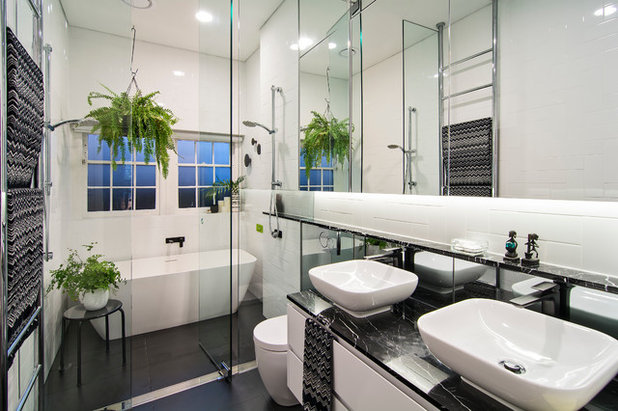

























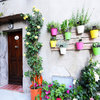



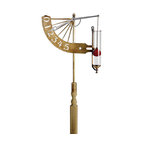








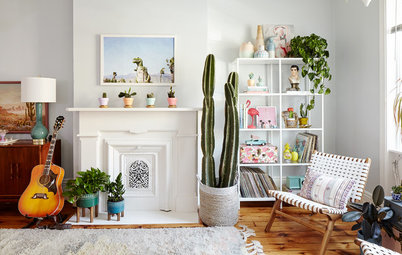



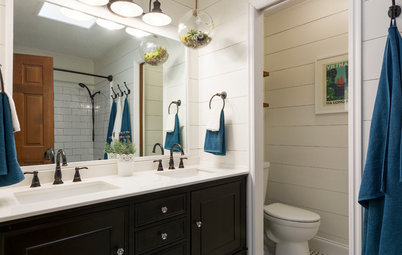


Tell us more about growing the sweet potato! It is gorgeous!
Another idea I use when I’m away is a tray filled with rocks and water to bring up the humidity, or sometimes, I set them all on the metal grid that protects our sink bottom. Then I add water just near the planter-bottoms.
In the summer, at the west windows of our dining room, I set colored sea glass in a rimmed crystal platter, add water, then set the platter in a silver tray. The planters sit on top.
I guess just about anything could work, like colorful marbles tightly-fitted and layered over a lipped plastic tray, or even cleaned pebbles...